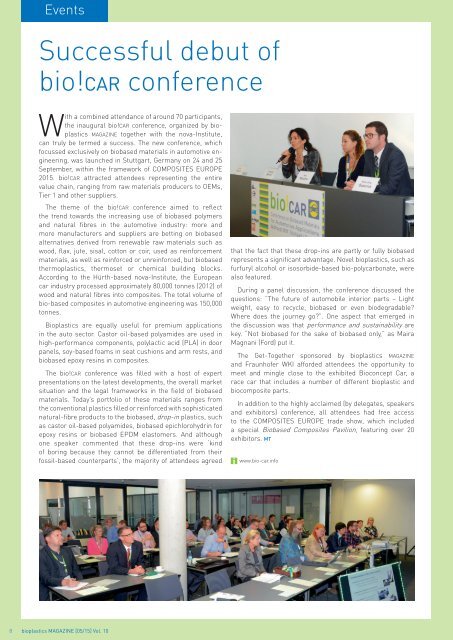Issue 05/2015
bioplasticsMAGAZINE_1505
bioplasticsMAGAZINE_1505
You also want an ePaper? Increase the reach of your titles
YUMPU automatically turns print PDFs into web optimized ePapers that Google loves.
Events<br />
Successful debut of<br />
bio!CAR conference<br />
With a combined attendance of around 70 participants,<br />
the inaugural bio!CAR conference, organized by bioplastics<br />
MAGAZINE together with the nova-Institute,<br />
can truly be termed a success. The new conference, which<br />
focussed exclusively on biobased materials in automotive engineering,<br />
was launched in Stuttgart, Germany on 24 and 25<br />
September, within the framework of COMPOSITES EUROPE<br />
<strong>2015</strong>. bio!CAR attracted attendees representing the entire<br />
value chain, ranging from raw materials producers to OEMs,<br />
Tier 1 and other suppliers.<br />
The theme of the bio!CAR conference aimed to reflect<br />
the trend towards the increasing use of biobased polymers<br />
and natural fibres in the automotive industry: more and<br />
more manufacturers and suppliers are betting on biobased<br />
alternatives derived from renewable raw materials such as<br />
wood, flax, jute, sisal, cotton or coir, used as reinforcement<br />
materials, as well as reinforced or unreinforced, but biobased<br />
thermoplastics, thermoset or chemical building blocks.<br />
According to the Hürth-based nova-Institute, the European<br />
car industry processed approximately 80,000 tonnes (2012) of<br />
wood and natural fibres into composites. The total volume of<br />
bio-based composites in automotive engineering was 150,000<br />
tonnes.<br />
Bioplastics are equally useful for premium applications<br />
in the auto sector. Castor oil-based polyamides are used in<br />
high-performance components, polylactic acid (PLA) in door<br />
panels, soy-based foams in seat cushions and arm rests, and<br />
biobased epoxy resins in composites.<br />
The bio!CAR conference was filled with a host of expert<br />
presentations on the latest developments, the overall market<br />
situation and the legal frameworks in the field of biobased<br />
materials. Today’s portfolio of these materials ranges from<br />
the conventional plastics filled or reinforced with sophisticated<br />
natural-fibre products to the biobased, drop-in plastics, such<br />
as castor oil-based polyamides, biobased epichlorohydrin for<br />
epoxy resins or biobased EPDM elastomers. And although<br />
one speaker commented that these drop-ins were ‘kind<br />
of boring because they cannot be differentiated from their<br />
fossil-based counterparts’, the majority of attendees agreed<br />
that the fact that these drop-ins are partly or fully biobased<br />
represents a significant advantage. Novel bioplastics, such as<br />
furfuryl alcohol or isosorbide-based bio-polycarbonate, were<br />
also featured.<br />
During a panel discussion, the conference discussed the<br />
questions: “The future of automobile interior parts – Light<br />
weight, easy to recycle, biobased or even biodegradable?<br />
Where does the journey go?”. One aspect that emerged in<br />
the discussion was that performance and sustainability are<br />
key. “Not biobased for the sake of biobased only,” as Maira<br />
Magnani (Ford) put it.<br />
The Get-Together sponsored by bioplastics MAGAZINE<br />
and Fraunhofer WKI afforded attendees the opportunity to<br />
meet and mingle close to the exhibited Bioconcept Car, a<br />
race car that includes a number of different bioplastic and<br />
biocomposite parts.<br />
In addition to the highly acclaimed (by delegates, speakers<br />
and exhibitors) conference, all attendees had free access<br />
to the COMPOSITES EUROPE trade show, which included<br />
a special Biobased Composites Pavilion, featuring over 20<br />
exhibitors. MT<br />
www.bio-car.info<br />
8 bioplastics MAGAZINE [<strong>05</strong>/15] Vol. 10


















